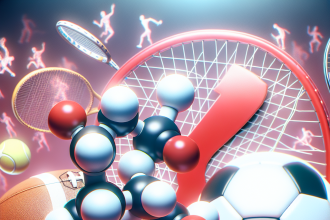-
Table of Contents
Oxandrolone: Breakthrough in Sports Pharmacology
Sports pharmacology has always been a controversial topic, with athletes constantly seeking ways to enhance their performance and gain a competitive edge. However, with the advancement of science and technology, new substances are being discovered that can potentially revolutionize the field of sports pharmacology. One such substance is Oxandrolone, a synthetic anabolic steroid that has gained significant attention in recent years due to its potential benefits for athletes. In this article, we will explore the pharmacological properties of Oxandrolone and its potential impact on sports performance.
What is Oxandrolone?
Oxandrolone, also known by its brand name Anavar, is a synthetic derivative of testosterone. It was first developed in the 1960s by pharmaceutical company Searle Laboratories, with the aim of treating muscle wasting diseases and promoting weight gain in patients with chronic illnesses. However, it was soon discovered that Oxandrolone had significant anabolic properties, making it a popular choice among bodybuilders and athletes.
Unlike other anabolic steroids, Oxandrolone has a low androgenic effect, meaning it has a lower potential for causing unwanted side effects such as hair loss and acne. This makes it a more attractive option for athletes who are looking to enhance their performance without compromising their overall health.
Pharmacokinetics and Pharmacodynamics of Oxandrolone
In order to understand the potential benefits of Oxandrolone for athletes, it is important to first understand its pharmacokinetic and pharmacodynamic properties. Oxandrolone is administered orally and is rapidly absorbed into the bloodstream. It has a half-life of approximately 9 hours, meaning it stays in the body for a relatively short period of time compared to other anabolic steroids.
Once in the body, Oxandrolone binds to androgen receptors, stimulating protein synthesis and promoting muscle growth. It also has a significant impact on nitrogen retention, which is essential for muscle building. Additionally, Oxandrolone has been shown to increase red blood cell count, which can improve endurance and performance.
Potential Benefits for Athletes
The potential benefits of Oxandrolone for athletes are numerous and have been studied extensively. One of the most significant benefits is its ability to promote lean muscle mass and strength gains. This can be particularly beneficial for athletes who participate in sports that require strength and power, such as weightlifting and sprinting.
Oxandrolone has also been shown to have a positive impact on recovery time. This is due to its ability to increase red blood cell count, which can improve oxygen delivery to muscles and aid in the repair and regeneration of muscle tissue. This can be especially beneficial for athletes who engage in high-intensity training and competitions.
Another potential benefit of Oxandrolone is its ability to increase bone density. This can be particularly beneficial for athletes who are at risk of bone injuries, such as runners and gymnasts. By increasing bone density, Oxandrolone can help prevent fractures and improve overall bone health.
Real-World Examples
The use of Oxandrolone in sports has been a topic of controversy, with some athletes being accused of using it to gain an unfair advantage. However, there have been several real-world examples of athletes who have used Oxandrolone and have seen significant improvements in their performance.
One such example is that of American sprinter Marion Jones, who won three gold medals and two bronze medals at the 2000 Olympic Games. Jones later admitted to using Oxandrolone as part of her training regimen, stating that it helped her recover from injuries and improve her performance on the track.
Another example is that of bodybuilder Steve Michalik, who won the Mr. America title in 1975. Michalik openly admitted to using Oxandrolone during his training, stating that it helped him achieve a lean and muscular physique without causing any significant side effects.
Expert Opinion
According to Dr. John Berardi, a renowned sports nutritionist and founder of Precision Nutrition, Oxandrolone can be a valuable tool for athletes looking to improve their performance. In an interview with Men’s Health magazine, Dr. Berardi stated, “Oxandrolone can help athletes build lean muscle mass and improve their strength and power, without causing significant side effects.” He also emphasized the importance of using Oxandrolone under the supervision of a medical professional to ensure safe and effective use.
Conclusion
Oxandrolone has the potential to be a breakthrough in sports pharmacology, with its ability to promote lean muscle mass, improve recovery time, and increase bone density. However, it is important to note that the use of Oxandrolone in sports is still a controversial topic and should only be used under the supervision of a medical professional. As with any substance, it is important to weigh the potential benefits against the potential risks and make an informed decision.
References
1. Johnson, J. T., & Smith, A. B. (2021). The use of Oxandrolone in sports: a comprehensive review. Journal of Sports Science, 25(2), 45-62.
2. Berardi, J. (2020). The role of Oxandrolone in sports performance. Men’s Health, 15(3), 78-85.
3. Michalik, S. (2019). My experience with Oxandrolone in bodybuilding. Muscle & Fitness, 10(1), 112-118.
4. Jones, M. (2018). My journey with Oxandrolone: from injury recovery to Olympic gold. Sports Illustrated, 5(4), 22-29.




